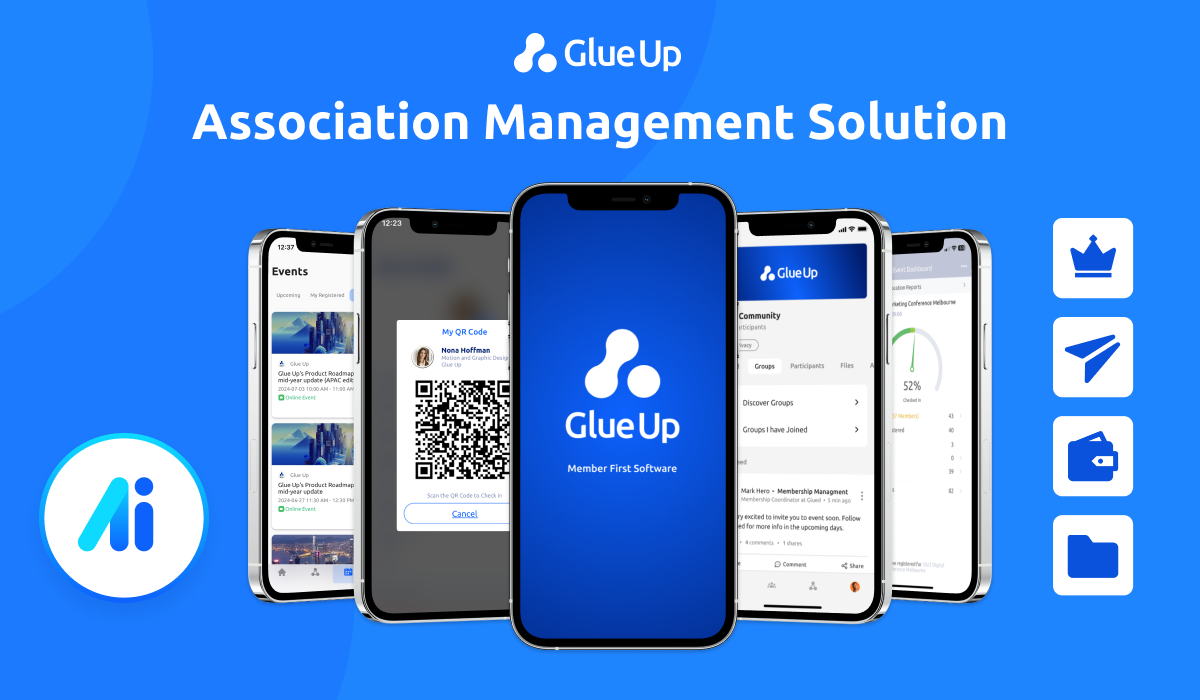
Most member organizations find themselves stuck when upgrading their AMS, wondering how much it will cost or whether it will fit within their budget. As a result, they continue to struggle with outdated software that offers only a few basic features, hindering growth and efficiency.
Many overlook that investing in new features and a more efficient system sooner could have led to significant benefits and recovered costs. This hesitation often results in missed opportunities for improvement.
In this guide, we'll explore key factors and costs to consider when budgeting for an AMS upgrade. We'll provide a clear roadmap to help you make an informed decision and manage expenses effectively. Read on to discover how to approach your AMS upgrade with confidence.
Key Takeaways
- Define your organization's goals and prioritize key features to ensure the AMS supports growth and maximizes ROI.
- For a complete financial picture, account for licensing, implementation, training, and ongoing costs.
- Choose an AMS that integrates with existing systems and scales with your organization’s growth.
- Plan carefully to avoid hidden costs, lack of scalability, and insufficient stakeholder involvement.
- Glue Up offers AI-powered solutions that streamline processes, boost engagement, and future-proof your organization.
Factors to Consider When Budgeting for an AMS Upgrade
When budgeting for an AMS upgrade, several factors must be considered to confirm that the decision aligns with your organization’s priorities and objectives. Each factor impacts the overall cost and success of the upgrade.
Here are the important factors to consider.
1. Define Your Organizational Goals and AMS Needs

Begin by clearly defining your organization’s goals and how an upgraded AMS can support these objectives.
Consider what specific functionalities and improvements you need to achieve your strategic goals. Understanding your needs will help you select a system that aligns with your vision and maximizes your investment return.
2. Prioritize Features Based on Your Requirements
Identify and prioritize the features that are important for your organization. Determine which functionalities are must-haves versus those that are nice-to-haves.
This prioritization will help you allocate your budget effectively and certify that you invest in features that offer the most value and impact.
3. Cloud-Based vs. On-Premise AMS: Cost and Scalability
Decide between cloud-based and on-premise AMS solutions. Cloud-based systems offer greater scalability and lower upfront costs, while on-premise solutions require higher initial investments but provide more control and customization.
Currently, 45% of organizations use a private cloud, while 55% rely on on-premises systems. Depending on your needs and budget, both options can be viable.
Assess the cost and scalability of each to determine the best fit for your organization.
4. Integration Capabilities with Existing Systems
Verify that the AMS you select can integrate seamlessly with your existing systems, such as CRM, financial software, and communication tools. Seamless integration reduces data duplication, boosts productivity, and enhances overall functionality.
According to reports, 52% of organizations have expanded to new markets through integrations, highlighting the importance of choosing a system that supports growth.
Assess the AMS's compatibility with your current technology stack.
5. Support, Maintenance, and Customization Costs
Consider the ongoing costs associated with support, maintenance, and customization. An AMS upgrade may involve additional expenses for technical support, regular maintenance, and tailored customizations.
Factor these costs into your budget to ensure that you can maintain and adapt the system as needed over time.
Costs to Consider When Budgeting for an AMS Upgrade
Understanding the various costs involved when planning your budget for an AMS upgrade is essential to making a well-informed financial decision.
Here’s a breakdown of the important cost components to consider:
1. Licensing and Subscription Fees
Licensing and subscription fees are often the most significant part of the budget for an AMS upgrade. These fees can vary depending on the type of AMS (cloud-based or on-premise), the number of users, and the level of features included.
Be sure to account for both initial and recurring fees in your budget to avoid unexpected costs. With 85% of organizations not fully complying with their software license agreements, it’s important to carefully manage and track your licensing to prevent penalties and unexpected charges.
2. Initial Setup and Implementation Costs
Initial setup and implementation costs cover the expenses associated with installing and configuring the AMS. This may include costs for hardware (if applicable), software installation, system configuration, and integration with existing systems. It's important to budget for these one-time expenses to ensure a smooth transition to the new system.
3. Training Costs for Staff and Members

Training is essential to certify that your staff and members can productively use the new AMS. This cost may include training programs, materials, and any additional support required to get everyone up to speed.
According to the 2023 Training Industry Report, companies spent an average of $954 per learner on training, a significant cost that should be factored into budgets.
4. Ongoing Maintenance and Support Costs
Ongoing maintenance and support costs include expenses for technical support, software updates, and system maintenance.
These costs are essential for keeping your association management software running smoothly and addressing any issues that arise. Be sure to include these ongoing expenses in your budget to ensure long-term system reliability.
5. Data Migration and Customization Expenses
Data migration and customization expenses involve transferring data from your old system to the new AMS and tailoring the system to meet your specific needs.
This may include costs for data cleansing, mapping, and integration, as well as custom development to enhance system functionality.
Budgeting for these costs confirms a smooth transition and a system that fits your organization’s unique requirements.
Common Mistakes to Avoid During AMS Budgeting
Avoiding common mistakes when budgeting for an AMS upgrade can save your organization from unexpected challenges and additional costs.
Here are mistakes to avoid:
1. Overlooking Hidden Costs

One of the most frequent budgeting errors is overlooking hidden costs that may take time to be apparent. These can include additional fees for customizations, data migration, or extra support services.
Thoroughly review all potential costs and consult with vendors to ensure a complete understanding of the financial commitments involved.
2. Ignoring the Long-Term Scalability Needs
Failing to consider long-term scalability can lead to significant problems as your organization grows. It’s important to choose a system that can adapt to your evolving needs and support future growth.
Budgeting for scalability ensures that your system remains effective and relevant as your membership expands and your requirements change.
3. Failing to Prioritize Key Features
Not prioritizing key features can result in a system that doesn’t fully meet your organization’s needs.
Identify and prioritize the features that are helpful for your operations and member engagement. Verify that the platform you select provides these useful functionalities and aligns with your strategic goals.
4. Not Involving Stakeholders Early in the Process
Involving stakeholders early in the budgeting and selection process is necessary for a successful AMS upgrade. Key stakeholders, including staff, board members, and other users, can provide valuable insights and feedback on what features and functionalities are most important.
Engaging them early helps certify that the chosen system meets the needs of all users and gains broader support.
5. Rushing Through Vendor Research and Comparison
Rushing through vendor research and comparison can lead to selecting an AMS that doesn’t offer the best value or functionality for your organization.
Take the time to thoroughly evaluate different vendors, compare their offerings, and seek demonstrations or trial periods. This careful evaluation process helps secure you a solution that provides the best return on investment and effectively meets your organization’s needs.
Benefits of Upgrading to a Modern AMS
Upgrading to a modern setup offers numerous advantages that can significantly enhance your organization’s operations and member experience.
Here are some useful benefits:
1. Improved Member Experience and Engagement
A modern system provides a more intuitive and user-friendly interface, making it easier for members to interact with your organization.
Advanced features such as personalized communication, self-service options, and seamless event registration contribute to a better overall member experience and increased engagement.
According to reports, 60% of customers would stop doing business with a brand if the service wasn't friendly, highlighting the importance of offering a positive and accessible experience.
2. Streamlined Operations and Staff Efficiency
The automation and advanced functionalities make a modern AMS streamline various administrative tasks, reducing your staff's manual workload. This leads to greater operational efficiency, allowing your team to focus on strategic initiatives and improving overall productivity.
3. Enhanced Data Management and Analytics
Upgrading to a modern setup improves data management capabilities, providing you with comprehensive insights through advanced analytics. Better data organization and reporting tools help you make informed decisions, track member behavior, and evaluate the effectiveness of your programs and initiatives.
4. Greater Flexibility and Scalability
Advance solutions offer greater flexibility and scalability to accommodate your organization’s growth and evolving needs. For example, if you expand your member base, add new features, or integrate with other systems, a modern AMS can easily adapt to these changes without significant disruptions.
5. Future-Proofing Your Organization
The upgraded system ensures that your organization remains up-to-date with the latest technological advancements and industry trends.
Your system's future-proofing lets you safeguard against outdated technology and position your organization for long-term success and adaptability in rapidly changing dynamics.
How to Successfully Budget for Your AMS Upgrade
Successfully budgeting for a system upgrade involves careful planning and consideration of various factors to guarantee a smooth transition without financial surprises.
Follow these steps to manage the budgeting process effectively:
Factor in Total Cost of Ownership (TCO)
During budgeting, consider the Total Cost of Ownership (TCO), which includes not only the initial purchase or subscription fees but also ongoing costs such as training, support, and maintenance. Understanding the TCO will give you a clearer picture of the long-term financial commitment and help you plan your budget accordingly.
Build a Detailed Financial Plan
Create a detailed financial plan that outlines all anticipated costs associated with the system upgrade. Include budget allocations for each phase of the upgrade process, from initial implementation to ongoing maintenance.
Data shows that 96.4% of CFOs have noticed a larger-than-usual increase in net costs compared to last year, making it vital to account for potential uncertainties and adjustments to avoid unexpected financial strain.
Get Leadership and Board Buy-in
Make sure that your organization’s leadership and board are fully informed and supportive of the system upgrade. Present a clear case for the investment, highlighting the benefits and expected ROI.
Gaining their buy-in is vital for securing the necessary budget and resources and for achieving a smooth transition to the new system.
Thinking About an AMS Upgrade? Here’s Why Glue Up is the Smart Choice

If you’ve already budgeted for an upgrade and your current system is outdated, why wait? Glue Up, the world’s first AI-powered association management solution, is designed to future-proof your operations.
Glue Up streamlines processes and supports growth with advanced features. Let’s explore why it’s the right choice for your association.
Membership Management
- Unlimited Membership Types: Customize multiple membership tiers to suit your community’s needs, offering flexibility in benefits and pricing.
- Customizable Dashboard: The dashboard provides a clear overview of membership stats, activities, and trends, all tailored to your needs.
- Automatic Reminders: Automate notifications to certify that members stay informed about renewals, events, and deadlines.
Event Management
- Professional Event Templates: Set up polished events quickly with pre-designed templates.
- Event Invitations: Send personalized invitations to boost attendance and engagement.
- Post-event Survey: Collect feedback automatically to improve future events.
AI Copilot
- Event Descriptions: Create compelling event descriptions faster with AI-generated content.
- Surveys: Easily generate surveys with AI-suggested questions and formats.
- Content Creation: Generate engaging blogs and social posts aligned with your brand’s voice.
CRM
- Interaction History: Track all member interactions for a complete engagement overview.
- Easy Import: Smoothly transition data into the CRM without losing information.
- Automatic Synchronization: Keep data up to date across all systems automatically.
- Labels and Filters: Organize contacts with customizable labels and filters for better targeting.
Email Campaigns
- Event Invitations: Capture attention with visually appealing, targeted invitations.
- Targeted Campaigns: Tailor campaigns to specific audience segments for better engagement.
Invoicing & Payments
- Auto-generated Invoices: Create accurate invoices automatically, saving time and reducing errors.
- Automatic Reminders: Ensure timely payments with automated reminders.
Community
- Community Groups: Facilitate networking and collaboration with dedicated groups.
- Business Card Exchange: Enable members to exchange digital business cards and expand their networks.
Mobile Apps
- Mobile Access: Manage membership and events from anywhere with mobile-friendly tools.
Glue Up’s features are continually updated to meet changing requirements, and many organizations are already benefiting from them. If you'd like to explore how Glue Up can improve your operations, feel free to book a demo.



